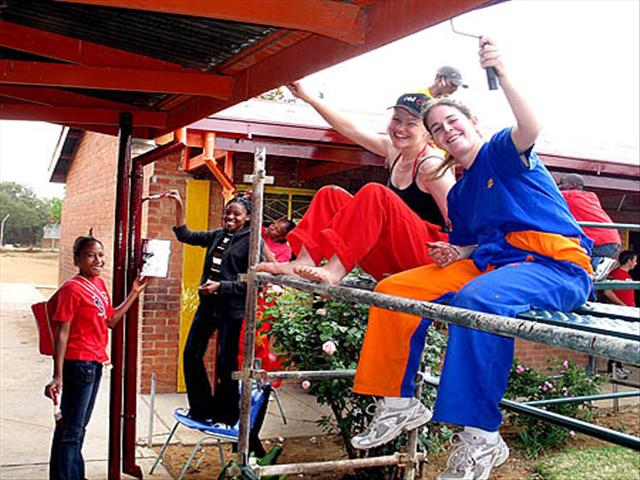Photo gallery
About 250 hostel students of the University of the Free State's (UFS) main campus yesterday painted and renovated four schools in the black townships of Bloemfontein. This was part of Kovsie Rag's new approach to be more directly involved with communities.
Students were transported with busses and performed tasks such as the painting of class rooms and outside walls and the cleaning and painting of gutters and window panes. The painting was judged by a panel of judges, that included the Rector and Vice-Chancellor, Prof Frederick Fourie. These points will contribute to the each hostel's final point in the Rag fund raising campaign for 2005/2006.

Some of the students who painted the gutters of Maboloka Primary School in Bochabelo were from the left Ms Tume Kowang (18) (first year student in B Accounting from NJ van der Merwe hostel); Ms Gloria Mangwane (19) (third year student in B Sc Biochemy from NJ van der Merwe hostel); Ms Adri Ras (21) (second year student in Occupational Therapy from Emily Hobhouse hostel) and Ms Malandi Els (20) (third year student in B Exercise and Feeding from Emily Hobhouse hostel).
See attached media statement:
UFS Rag and Eimpa paints assist with upgrading of schools
The spirit of Ubuntu will this year be truly reflected in the University of the Free State’s (UFS) Rag community out reach programme when senior students from the 23 hostels on the Main Campus will visit four less-privileged schools in the Mangaung area on Saturday 8 October 2005 to assist these schools in the upgrading of facilities.
The same day (Saturday 8 October 2005) the UFS first year students will visit the neighbourhoods in Bloemfontein from 08:00-13:00 to raise funds on an Ubuntu donation lists for Rag 2005/2006.
The Ubuntu project was started about seven years ago and it has grown each year. In the past the project was associated with a fundraising leg and a hostel publicity leg. This year the aim is to involve the community to demonstrate how important fundraising initiatives are to help those less-privileged.
The schools that will be visited are Legae Intermediary School in Batho, Mothusi Primary School in Rocklands, and the Maboloka and Lesedi Primary Schools in Bochabelo. The schools in the Manugaung area had until 31 August 2005 to complete a questionnaire identifying what assistance is needed. The Rag office, with the help of professional consultants from Eimpa Paints, chose four schools and visited each one to determine material/s needed to complete the work.
Eimpa Paints is a partner of the Ubuntu project and will be sponsoring all paint necessary to complete the work at the schools. All other material/s needed will be supplied by the UFS Rag office.
The hostels are divided into project teams and will clean and paint gutters and window sills and paint the walls of classrooms and outside walls. At Maboloka School for instance, a project team will also to paint a wall with colourful characters.
Media release
Issued by: Lacea Loader
Media Representative
Tel: (051) 401-2584
Cell: 083 645 2454
E-mail: loaderl.stg@mail.uovs.ac.za
7 October 2005